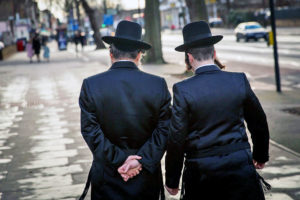What does a Jew look like? If you ask this slightly suspicious question, most people’s minds will conjure a stereotype. The Woody Allen type: scrawny, cerebral, wears horn-rimmed glasses and probably has a prominent nose. Few people would immediately think of Drake, even though his Jewishness via his matrilineal line is as solid as Allen’s. Mine is, too, on my paternal side — not that anyone ever guesses. Drake and I, after all, are black men with afros, and most people assume that Jews have white skin.
Yet it was only after the Second World War that Jews became white. A new book by Emily Tamkin tells the story of how the racial identity of American Jews evolved. Bad Jews: A History of American Jewish Politics and Identities reminds us, again and again, of something too often forgotten: Jewry isn’t homogenous, and its ethnic character hasn’t always been static.
The early Jewish community in America, from the time of the revolution, was largely Sephardic — that is, Southern European and North African. Paler-skinned Ashkenazim from Germany and Central Europe, who were more bourgeois and assimilationist, didn’t arrive in significant numbers until the mid-19th century. But it was the mass migration of poor, oppressed Jews from the Russian empire, which began a few decades later, that dramatically altered the composition and culture of American Jewry, making Ashkenazim overwhelmingly dominant. That’s not to say American Ashkenazim were a cohesive, mutually supportive ethnic group. The earlier settlers feared that the newcomers, with their markedly different cultures and Yiddish language, would give Jews a bad reputation.
When they first arrived in significant numbers, the pale skin of Ashkenazim Jews was not a privilege. Those who settled in America faced considerable social and cultural prejudice — and certainly weren’t viewed as white. After the First World War, the images of Jews in pop culture were quite often of gangsters or Bolshevik subversives. During the Second, the American state was not enthusiastic about accepting Jewish refugees from the Holocaust. One of the reasons behind the opposition to America intervening in “European entanglements” was suspicion that it would be doing so at the behest of Jewish power.
Nevertheless, despite the discrimination they faced, the philosophy of the diaspora was assimilationist and remarkably successful. Over the course of the 20th century, Jews gradually transitioned away from living in the urban slums of the Lower East Side — with their radical socialist politics, Yiddish culture, and strong association with Jewish ethnic identity — and into the leafy middle-class suburbs of white bread America. Now, Jews are among the most socially integrated groups in America. Total assimilation is commonly accessible for those that want it. A Jew, in other words, can be Jewish by choice.
The title of Norman Podhoretz’s memoir, Making It, captures the post-war ethos of American Jewry. Loyalty should be pledged to America. Jews shouldn’t stress their particularity. They should become “white”. The GI Bill, which virtually excluded black people in practice, as Tamkin notes, “enshrined their status as white Americans”, enabling them to become “publicly, outwardly all-American and privately religiously all-Jewish”. Whiteness, for many American Jews, was a result of assimilation: it meant stability, material comfort, upward social mobility, and safety.
Jews have never been an oppressed minority in America. Even early migrants faced nothing like the systematic oppression of the Pale of Settlement, which they fled from. When David Ben-Gurion toured America in 1916, he noted the existence of a “Negro Pale of Settlement” in Nashville, which does put things in perspective. And it wasn’t just Jewish immigrants who were treated as outsiders. The Irish, Italians, Poles — most ethnically “white” arrivals in the 19th and 20th centuries were treated as “alien” by an America that unofficially defined itself as White, Anglo-Saxon and Protestant; most were accepted into the mainstream and ultimately seen as white, which entailed moving up the social hierarchy. All were regarded much more favourably than black Americans.
And yet, there’s something fraught and imprecise about describing American Jews as “white” in the same way one would describe a Polish-American as white. It doesn’t completely fit. Considering how Jews have been among the most detested groups in history, it seems callous to casually claim we benefit from “white privilege”. As David Baddiel argued in Jews Don’t Count, contemporary anti-racism excludes Jews to the point of legitimising antisemitism, by regarding Jews as participating in racist structures against people of colour. It’s true that in Western countries, Jews don’t face the institutionalised oppression that other minorities may do and largely. Jews are included in national identities, while being free to preserve Jewish culture. None of this suggests antisemitism doesn’t exist.
Moreover, as Tamkin usefully points out, any association with Jews and “whiteness” has the problem of taking the Ashkenazim as the sole paradigm of Jewishness. Obviously, this isn’t the case. Judaism has had a historic presence in so many societies across the world; Jews come in different appearances and hues, imbued with different cultures. In Israel, at least half, possibly a slight majority, of the Jewish population is visibly “non-white” — the nation airlifted 14,000 Jews out of Ethiopia over two days in 1991. Far-Right parties draw much of their support from this demographic, puncturing many of the assumptions about Israel’s supposed “white supremacy”. But an overwhelming majority of American Jews are Ashkenazim, and because American culture dominates the world, Ashkenazim end up representing “authentic” Jewish identity worldwide. Ethiopian Jews are overlooked, despite being one of the most ancient Jewish communities, and much of the way we discuss Judaism is white-centric.
This mentality also affected Jews themselves. Within America, Jews have divided and demonised one another. Many Ashkenazim, as Tamkin reveals, regarded their Sephardic co-religionists as “bad Jews”, or not Jews at all, since they didn’t speak Yiddish, didn’t pray in the same way and looked different. In her history of Sephardic Jews in America, Aviva Ben-Ur recounts stories of Ashkenazic landlords in New York excluding Sephardic Jews from lodging, and petitioning Mayor William Jay Gaynor to “remove these Turks from our midst”.
Throughout American history, groups condemned to the lower rungs of the social ladder often disdain those even lower down the racial hierarchy than they are. Black people, being right at the bottom, bear the brunt of this retaliatory discrimination. There is a history, which Tamkin documents, of Jewish leaders arguing that Jews are white for immigration purposes, of Jewish leaders using the language of eugenics to abjure the connection between Jews and Africans commonly made by racial scientists, of bigoted Jewish shop owners discriminating against black customers. Tamkin also notes that, “Jewish support for civil rights was not unanimous”. Reactionaries such as Norman Podhoretz and Nathan Glazer saw the “Negro revolution” as a threat to Jewish security. Their case, as Tamkin describes, was based on the premise that Jews “belonged to white America and one need only look at Black America to see that that was true”.
Their attitude was not universal, however. Many progressive Jews, such as Rabbi Abraham Joshua Heschel, avidly supported equal rights — and indeed were overrepresented among the white people that joined the freedom marches in the South. And prominent black leaders also supported Jewish causes: Paul Robeson, Bayard Rustin and W. E. B. Du Bois were vocal about sympathising with Zionism, out a deep affinity and solidarity with the plight of European Jewry.
Indeed, some Jews were, to use Leonard Fein’s phrase, the “unintended beneficiaries” of the black-power style. Jewish leaders took inspiration from black-power activists: if blacks can advocate for blackness, then Jews can advocate for Jewishness. The zenith of black power coincided with Israel’s triumph in the Six-Day War of 1967, after which American Jews embraced Zionism more fully. “The perceived heroism of Israel,” Tamkin writes, “led some Jews to identify openly as Jews.” This embrace of Israel, ironically, was a function of American Jews finally “making it”: being fully integrated into the fabric of America. They could adopt a dual identity without being accused of “dual loyalty”. Israel becoming a key strategic ally of America helped in this regard. Supporting the state complimented American patriotism and fealty to liberal democratic values.
And of course, black people and Jews are not a mutually exclusive group. Tamkin estimates that there are as many as 1.2 million black American Jews, whose Jewishness is so often be ignored, including by Jews themselves, because they don’t “look” the part. They are mostly a product not of immigration but the erosion of the stigma directed at interracial marriage. Their Jewishness therefore tends to be Ashkenazic, whereas the only vague blueprint for black Jewishness rests on an indigenous African version of the religion. Ethiopian Jews, isolated from the rest of the Jewish universe, also face racism in Israel. The double consciousness of being both black and Jewish remains more vexed than that of being both American and Jewish. If becoming “white” is the only way for Jews to escape cultural prejudice, what are black Jews supposed to do?
Disclaimer
Some of the posts we share are controversial and we do not necessarily agree with them in the whole extend. Sometimes we agree with the content or part of it but we do not agree with the narration or language. Nevertheless we find them somehow interesting, valuable and/or informative or we share them, because we strongly believe in freedom of speech, free press and journalism. We strongly encourage you to have a critical approach to all the content, do your own research and analysis to build your own opinion.
We would be glad to have your feedback.
Source: UnHerd Read the original article here: https://unherd.com/




